Ferdinand I of Austria
Ferdinand I (German: Ferdinand I. 19 April 1793 – 29 June 1875) was the Emperor of Austria from 1835 until his abdication in 1848. As ruler of Austria, he was also President of the German Confederation, King of Hungary, Croatia and Bohemia (as Ferdinand V), King of Lombardy–Venetia and holder of many other lesser titles (see grand title of the Emperor of Austria). Due to his rocky, passive but good-intended character, he gained the sobriquet The Benign (German: Der Gütige) or The Good (Czech: Ferdinand Dobrotivý).[2]
| Ferdinand I & V | |||||
|---|---|---|---|---|---|
 Ferdinand in Austrian Field Marshal uniform, portrait by Eduard Edlinger, 1843 | |||||
| Emperor of Austria (more...) | |||||
| Reign | 2 March 1835 – 2 December 1848 | ||||
| Coronation | 7 September 1836, Prague (as king of Bohemia) | ||||
| Predecessor | Francis I | ||||
| Successor | Franz Joseph I | ||||
| Prime Minister | See list | ||||
| Head of the Präsidialmacht Austria | |||||
| In office | 2 March 1835 – 1 May 1850 | ||||
| Predecessor | Francis I | ||||
| Successor | Francis Joseph I | ||||
| King of Hungary | |||||
| Reign | 28 September 1830 – 2 December 1848 | ||||
| Coronation | 28 September 1830, Pressburg | ||||
| Predecessor | Francis I | ||||
| Successor | Franz Joseph I | ||||
| Born | 19 April 1793 Vienna, Austria, Holy Roman Empire[1] | ||||
| Died | 29 June 1875 (aged 82) Prague, Kingdom of Bohemia, Austria-Hungary[1] | ||||
| Burial | Imperial Crypt, Vienna | ||||
| Spouse | |||||
| |||||
| House | Habsburg-Lorraine | ||||
| Father | Francis II, Holy Roman Emperor | ||||
| Mother | Maria Theresa of the Two Sicilies | ||||
| Religion | Roman Catholicism | ||||
Ferdinand succeeded on the death of his father Francis II and I on 2 March 1835. He was incapable of ruling his empire because of his mental deficiency, so his father, before he died, made a will which promulgated that Ferdinand should consult Archduke Louis on all aspects of internal policy and urged him to be influenced by Prince Metternich, Austria's Foreign Minister.[3]
Following the Revolutions of 1848, Ferdinand abdicated on 2 December 1848. He was succeeded by his nephew, Franz Joseph. Following his abdication, he lived in Hradčany Palace, Prague, until his death in 1875.[4]
Ferdinand married Maria Anna of Savoy, the sixth child of Victor Emmanuel I of Sardinia. They had no children.
Biography
Early life
Ferdinand was the eldest son of Francis II, Holy Roman Emperor and Maria Theresa of Naples and Sicily. Possibly as a result of his parents' genetic closeness (they were double first cousins), Ferdinand suffered from epilepsy, hydrocephalus, neurological problems, and a speech impediment. He was educated by Baron Josef Kalasanz von Erberg, and his wife Josephine, by birth a Countess von Attems.[5]
Reign
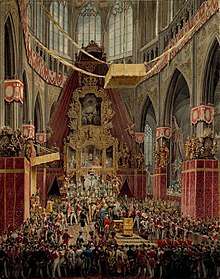
Ferdinand has been depicted as feeble-minded and incapable of ruling. Yet, although he had epilepsy, he kept a coherent and legible diary and has even been said to have had a sharp wit. However, suffering as many as twenty seizures per day severely restricted his ability to rule with any effectiveness. Though he was not declared incapacitated, a Regent's Council (Archduke Louis, Count Kolowrat, and Prince Metternich) steered the government.
When Ferdinand married Princess Maria Anna of Savoy, the court physician considered it unlikely that he would be able to consummate the marriage.[6] When he tried to consummate the marriage, he had five seizures. He is best remembered for his command to his cook: when told he could not have apricot dumplings (Marillenknödel) because apricots were out of season, he said "I am the Emperor, and I want dumplings!" (German: Ich bin der Kaiser und ich will Knödel!).[7][8]
1848 Revolution

As the revolutionaries of 1848 were marching on the palace, he is supposed to have asked Metternich for an explanation. When Metternich answered that they were making a revolution, Ferdinand is supposed to have said "But are they allowed to do that?" (Viennese German: Ja, dürfen's denn des?) He was convinced by Prince Felix of Schwarzenberg to abdicate in favour of his nephew, Franz Joseph (the next in line was Ferdinand's younger brother Franz Karl, but he was persuaded to waive his succession rights in favour of his son) who would occupy the Austrian throne for the next sixty-eight years.
Ferdinand recorded the events in his diary: "The affair ended with the new Emperor kneeling before his old Emperor and Lord, that is to say, me, and asking for a blessing, which I gave him, laying both hands on his head and making the sign of the Holy Cross ... then I embraced him and kissed our new master, and then we went to our room. Afterwards I and my dear wife heard Holy Mass ... After that I and my dear wife packed our bags."
In retirement (1848–1875)
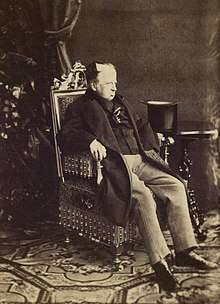
Ferdinand was the last King of Bohemia to be crowned as such. Due to his sympathy with Bohemia (where he spent the rest of his life in Prague Castle) he was given the Czech nickname "Ferdinand V, the Good" (Ferdinand Dobrotivý). In Austria, Ferdinand was similarly nicknamed "Ferdinand der Gütige" (Ferdinand the Benign), but also ridiculed as "Gütinand der Fertige" (Goodinand the Finished).
He is interred in tomb number 62 in the Imperial Crypt in Vienna.
Titles and honours
He used the titles:[9]
His Imperial and Royal Apostolic Majesty Ferdinand the First, By the Grace of God
- Emperor of Austria, King of Hungary, Bohemia, fifth by this name, King of Lombardy and Venice, King of Dalmatia, Croatia, Slavonia, Galicia, Lodomeria, and Illyria;
- King of Jerusalem etc.
- Archduke of Austria
- Grand duke of Tuscany and Cracow [from 1846];
- Duke of Lorraine, Salzburg, Styria, Carinthia and Carniola, Upper and Lower Silesia, of Modena, Parma, Piacenza and Guastalla, of Auschwitz and Zator, of Teschen, Friuli, Ragusa, and Zara;
- Grand prince of Transylvania;
- Margrave of Moravia;
- Princely Count of Habsburg, Kyburg, Tyrol, Gorizia and Gradisca;
- Prince of Trent and Brixen;
- Margrave of Upper and Lower Lusatia and in Istria, Count of Hohenems, Feldkirch, Bregenz, Sonnenberg, etc.
- Lord of Trieste, Cattaro and over the Windic March.
Honours
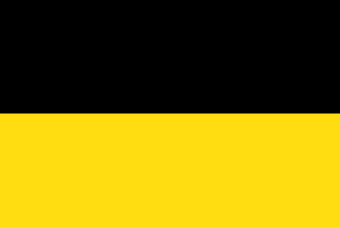
- Knight of the Golden Fleece, 1793[11]
- Grand Cross of St. Stephen, 1830[12]
- Grand Cross of the Imperial Order of Leopold
- Knight of the Iron Crown, 1st Class
- France:
.svg.png)

.svg.png)



.svg.png)
.svg.png)

.svg.png)
.svg.png)

.svg.png)
.svg.png)
.svg.png)

.svg.png)
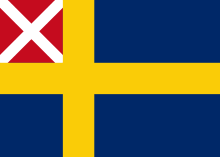
.svg.png)
.svg.png)
.svg.png)

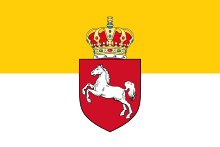
.svg.png)
.svg.png)
Ancestry
| Ancestors of Ferdinand I of Austria | |||||||||||||||||||||||||||||||||||||||||||||||||||||||||||||||||||||||||||||||||||||||||||||||||||||||||||||||||||||||||||||||||||||||||||||||||||||||||||||||||||||||||||||||||||||||||||||||||||||||||||||||||||||||||||||||||||||||||||||||||||||||||||||||||||||||||||||||||||||||||
|---|---|---|---|---|---|---|---|---|---|---|---|---|---|---|---|---|---|---|---|---|---|---|---|---|---|---|---|---|---|---|---|---|---|---|---|---|---|---|---|---|---|---|---|---|---|---|---|---|---|---|---|---|---|---|---|---|---|---|---|---|---|---|---|---|---|---|---|---|---|---|---|---|---|---|---|---|---|---|---|---|---|---|---|---|---|---|---|---|---|---|---|---|---|---|---|---|---|---|---|---|---|---|---|---|---|---|---|---|---|---|---|---|---|---|---|---|---|---|---|---|---|---|---|---|---|---|---|---|---|---|---|---|---|---|---|---|---|---|---|---|---|---|---|---|---|---|---|---|---|---|---|---|---|---|---|---|---|---|---|---|---|---|---|---|---|---|---|---|---|---|---|---|---|---|---|---|---|---|---|---|---|---|---|---|---|---|---|---|---|---|---|---|---|---|---|---|---|---|---|---|---|---|---|---|---|---|---|---|---|---|---|---|---|---|---|---|---|---|---|---|---|---|---|---|---|---|---|---|---|---|---|---|---|---|---|---|---|---|---|---|---|---|---|---|---|---|---|---|---|---|---|---|---|---|---|---|---|---|---|---|---|---|---|---|---|---|---|---|---|---|---|---|---|---|---|---|---|---|---|---|---|
| |||||||||||||||||||||||||||||||||||||||||||||||||||||||||||||||||||||||||||||||||||||||||||||||||||||||||||||||||||||||||||||||||||||||||||||||||||||||||||||||||||||||||||||||||||||||||||||||||||||||||||||||||||||||||||||||||||||||||||||||||||||||||||||||||||||||||||||||||||||||||
Ferdinand's parents were double first cousins as they shared all four grandparents (Francis' paternal grandparents were his wife's maternal grandparents and vice versa). Therefore, Ferdinand only had four great-grandparents, being descended from each of them twice. Further back in his ancestry there is more pedigree collapse due to the close intermarriage between the Houses of Austria and Spain and other Catholic monarchies.
See also
- Charles II of Spain (1661–1700)
- List of heirs to the Austrian throne
- Rulers of Germany family tree. He was related to every other ruler of Germany.
References
- Chisholm, Hugh, ed. (1911). . Encyclopædia Britannica (11th ed.). Cambridge University Press.
- Thomas Nipperdey: Deutsche Geschichte 1800-1866. Bürgerwelt und starker Staat, C.H. Beck, broschierte Sonderausgabe 1998, S. 339.
- Taylor, A. J. P.: "The Habsburg Monarchy 1809-1918" (Penguin Books, Great Britain, 1990, ISBN 978-0-14-013498-8), pp 52-53
- van der Kiste, p 16
- Grafenauer, Bogo (1925–1991). "Erberg Jožef Kalasanc baron" [Erberg Joseph Calasanz baron]. In Cankar, Izidor; et al. (eds.). Slovenski biografski leksikon (in Slovenian). ISBN 978-961-268-001-5. Archived from the original on 2012-01-28. Retrieved 2012-05-01.
- van der Kiste, John. Emperor Francis Joseph London: Sutton Publishing, 2005 ISBN 0-7509-3787-4. p 2
- According to A.J.P. Taylor, he was in fact asking for noodles - "But it is an unacceptable pun in English for a noodle to ask for noodles" - The Habsburg Monarchy 1809–1918
- Regan, Geoffrey. Royal Blunders page 72
- Velde, Francois R. "Royal Styles". www.heraldica.org.
- "Ritter-Orden", Hof- und Staatshandbuch des Kaiserthumes Österreich, 1834, pp. 23, 34, 41, 57, retrieved 18 June 2020
- Boettger, T. F. "Chevaliers de la Toisón d'Or - Knights of the Golden Fleece". La Confrérie Amicale. Retrieved 25 June 2019.
- "A Szent István Rend tagjai" Archived 22 December 2010 at the Wayback Machine
- Teulet, Alexandre (1863). "Liste chronologique des chevaliers de l'ordre du Saint-Esprit depuis son origine jusqu'à son extinction (1578-1830)" [Chronological List of Knights of the Order of the Holy Spirit from its origin to its extinction (1578-1830)]. Annuaire-bulletin de la Société de l'histoire de France (in French) (2): 114. Retrieved 20 May 2020.
- Hof- und Staatshandbuch des Königreichs Bayern: 1833. Landesamt. 1833. p. 6.
- Almanacco di corte (in Italian). 1858. Retrieved 2019-04-24.
- "Großherzogliche Orden und Ehrenzeichen", Hof- und Staatshandbuch des Großherzogtums Hessen: für das Jahr ... 1858 (in German), Darmstadt, 1858, p. 8, retrieved 12 March 2020
- Hessen-Kassel (1858). Kurfürstlich Hessisches Hof- und Staatshandbuch: 1858. Waisenhaus. p. 15.
- Hof- und Staats-Handbuch des Großherzogtum Baden (1834), "Großherzogliche Orden" pp. 32, 50
- Sachsen (1866). Staatshandbuch für den Freistaat Sachsen: 1865/66. Heinrich. p. 3.
- Württemberg (1858). Königlich-Württembergisches Hof- und Staats-Handbuch: 1858. Guttenberg. p. 31.
- Luigi Cibrario (1869). Notizia storica del nobilissimo ordine supremo della santissima Annunziata. Sunto degli statuti, catalogo dei cavalieri. Eredi Botta. p. 105.
- Liste der Ritter des Königlich Preußischen Hohen Ordens vom Schwarzen Adler (1851), "Von Seiner Majestät dem Könige Friedrich Wilhelm III. ernannte Ritter" p. 19
- J ..... -H ..... -Fr ..... Berlien (1846). Der Elephanten-Orden und seine Ritter. Berling. pp. 166–167.
- Staatshandbuch für das Großherzogtum Sachsen / Sachsen-Weimar-Eisenach (1864), "Großherzogliche Hausorden" p. 11
- Sveriges och Norges Statskalender (in Swedish), 1864, p. 421, retrieved 2019-02-20 – via runeberg.org
- "Herzogliche Sachsen-Ernestinischer Hausorden", Adreß-Handbuch des Herzogthums Sachsen-Coburg und Gotha (in German), Coburg, Gotha: Meusel, 1843, p. 4, retrieved 12 March 2020
- Anhalt-Köthen (1851). Staats- und Adreß-Handbuch für die Herzogthümer Anhalt-Dessau und Anhalt-Köthen: 1851. Katz. p. 10.
- Staat Hannover (1865). Hof- und Staatshandbuch für das Königreich Hannover: 1865. Berenberg. pp. 37, 73.
- "Caballeros Grandes Cruces de la Real y distinguida orden de Carlos Terceros", Guía Oficial de España (in Spanish), 1868, p. 167, retrieved 18 June 2020
- Almanacco Toscano per l'anno 1855. Stamperia Granducale. 1855. p. 272.
- Wurzbach, Constantin, von, ed. (1861). . Biographisches Lexikon des Kaiserthums Oesterreich [Biographical Encyclopedia of the Austrian Empire] (in German). 7. p. 60 – via Wikisource.
- Wurzbach, Constantin, von, ed. (1860). . Biographisches Lexikon des Kaiserthums Oesterreich [Biographical Encyclopedia of the Austrian Empire] (in German). 6. p. 208 – via Wikisource.
- Wurzbach, Constantin, von, ed. (1861). . Biographisches Lexikon des Kaiserthums Oesterreich [Biographical Encyclopedia of the Austrian Empire] (in German). 7. p. 53 – via Wikisource.
- Genealogie ascendante jusqu'au quatrieme degre inclusivement de tous les Rois et Princes de maisons souveraines de l'Europe actuellement vivans [Genealogy up to the fourth degree inclusive of all the Kings and Princes of sovereign houses of Europe currently living] (in French). Bourdeaux: Frederic Guillaume Birnstiel. 1768. p. 9.
- Wurzbach, Constantin, von, ed. (1861). . Biographisches Lexikon des Kaiserthums Oesterreich [Biographical Encyclopedia of the Austrian Empire] (in German). 7. p. 81 – via Wikisource.
External links
| Wikimedia Commons has media related to Ferdinand I of Austria. |
- Tomáš Kleisner, "Medals of the Emperor Ferdinand the Good 1793-1875" Prague 2013 ISBN 978-80-7036-396-6
- "Biography of Emperor Ferdinand"
- Literature by and about Ferdinand I in the German National Library catalogue
- Works by and about Ferdinand I of Austria in the Deutsche Digitale Bibliothek (German Digital Library)
- Ferdinand I In: Brockhaus Bilder-Conversations-Lexikon (in German), 2, Leipzig, 1837, pp. 25–26
- Ferdinand I In: Brockhaus' Kleines Konversations-Lexikon (in German), 1 (5 ed.), Leipzig, 1911, p. 569
- Ferdinand I of Austria in Austria-Forum (in German) (at AEIOU)
- Entry about Ferdinand I of Austria in the database Gedächtnis des Landes on the history of the state of Lower Austria (Lower Austria Museum)
Ferdinand I of Austria Cadet branch of the House of Lorraine Born: 19 April 1793 Died: 29 June 1875 | ||
| Regnal titles | ||
|---|---|---|
| Preceded by Francis I |
Emperor of Austria King of Hungary and Croatia King of Bohemia King of Lombardy–Venetia 1835–1848 |
Succeeded by Francis Joseph I |
| Political offices | ||
| Preceded by Francis I of Austria |
Head of the Präsidialmacht Austria 1835–1848 |
Succeeded by Franz Joseph I of Austria |
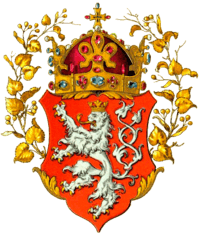
.svg.png)